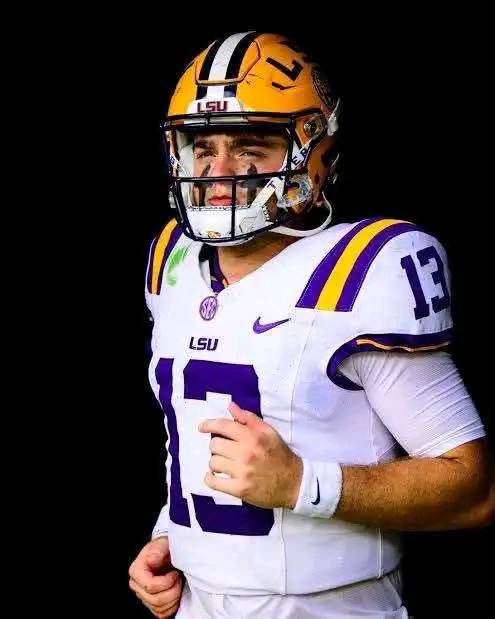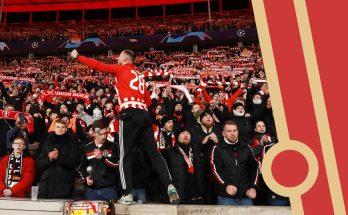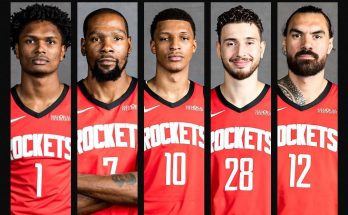Garrett Nussmeier’s $4.5 Million Rejection: Collegiate Loyalty in the Age of NIL and the Future of College Athletics
In an era dominated by money, branding, and self-interest in collegiate athletics, LSU quarterback Garrett Nussmeier’s decision to decline a reported $4.5 million NIL (Name, Image, and Likeness) offer from rival Alabama stands out as a moment of profound significance. This choice is not just a headline-grabbing anomaly—it could be a defining moment that challenges the assumptions many have about the direction of college sports in the name, image, and likeness era.
As universities increasingly battle for talent with financial firepower once reserved for professional leagues, Nussmeier’s decision to stick with the Purple and Gold of LSU speaks to deeper values of loyalty, identity, and purpose. It also invites a necessary conversation about the evolving relationship between student-athletes, institutions, and the communities that support them.
The Context: A Transformational Era in College Athletics
Since the NCAA’s decision to allow athletes to profit from their name, image, and likeness in 2021, the college sports world has undergone seismic changes. Star athletes are now able to earn millions before ever playing a down in the NFL, throwing a pitch in the MLB, or lacing up for the NBA. Recruiting has morphed into an open market, with top programs, collectives, and boosters leveraging massive NIL deals to attract elite talent.
In this new era, the traditional foundations of college sports—community, loyalty, team culture—are often perceived as subordinate to financial incentives. While NIL was a necessary reform to give athletes a fair share of the multibillion-dollar college athletics industry, its implementation has raised concerns about imbalance, recruitment tampering, and the professionalization of what were once amateur sports.
Garrett Nussmeier: The Man in the Spotlight
Garrett Nussmeier isn’t just another name in the college football quarterback carousel. The son of former NFL quarterback and coach Doug Nussmeier, Garrett has been groomed in football culture from a young age. His development at LSU has been marked by steady progress, and his decision to stay with the Tigers was expected by many to lead to a breakout 2025 campaign.
But when news broke that Nussmeier had been offered a $4.5 million NIL deal from Alabama—LSU’s bitter SEC West rival—and turned it down, the story transcended football. It became a symbol of something bigger.
This was more than a quarterback choosing one school over another. It was a highly sought-after athlete looking at a check worth more than many professionals make in a year—and still choosing to remain where he felt he belonged.
Loyalty vs. Lucre: A Rare Decision in a Changing Culture
In today’s college football environment, athletes transferring for better NIL deals is no longer shocking—it’s expected. For every Quinn Ewers or Caleb Williams who moves to a new school and benefits from major NIL opportunities, there are dozens of others making similar decisions in less publicized but equally financially motivated moves.
Nussmeier’s decision to stay bucks that trend. It represents a countercultural stance—a belief in the intrinsic value of program loyalty, relationships built over time, and a commitment to teammates, coaches, and fans.
This isn’t to say that athletes who chase NIL money are wrong. Quite the opposite: they are simply operating within a system that now recognizes their market value. But Nussmeier’s rejection of $4.5 million illustrates that, for some, college football still offers something money can’t buy—a chance to build a legacy rooted in tradition, growth, and gratitude.
Implications for LSU and Alabama
LSU: A Cultural and Competitive Win
For LSU, Nussmeier’s decision is more than just retention—it’s a validation of the culture head coach Brian Kelly is building. LSU is investing in developing players both on and off the field, and this moment proves that such investments pay dividends.
Nussmeier’s loyalty will likely resonate deeply with fans, recruits, and alumni. It projects a message that LSU is not just a stopover on the way to the NFL or a payday, but a destination where athletes can grow and achieve greatness while maintaining their values. This could become a critical part of LSU’s recruiting narrative moving forward.
Alabama: The NIL Powerhouse Meets Resistance
For Alabama, this is a rare public setback. Known for its powerhouse football program and robust NIL infrastructure, Alabama is used to being on the winning end of recruitment battles. That even a $4.5 million offer wasn’t enough to lure Nussmeier speaks to a possible limit in NIL’s influence.
It also raises questions about the sustainability and ethical implications of such aggressive offers. When does recruiting become coercion? And how can programs balance financial incentives with fostering authentic, long-term relationships?
The Broader NCAA Picture: Are We Reaching a Tipping Point?
Nussmeier’s decision forces a deeper examination of where college football—and college athletics in general—is heading. While the NIL era has brought much-needed progress and fairness, it has also introduced volatility, inflated expectations, and disparities across programs.
There is growing concern that athletes are being treated like mercenaries, moving from school to school based on the highest bidder. Nussmeier’s case suggests that not all players are willing to commodify their collegiate experience, and some still view their team as family, their school as home.
This doesn’t mean NIL is broken—it’s an essential step forward—but it does signal a need for refinement. Possible future developments might include:
- NIL Regulation: Federal or NCAA-level guidance could introduce more transparency, limit tampering, and standardize contracts.
- Transfer Reform: While players should retain freedom of movement, some are calling for more structured transfer windows and eligibility standards.
- Educational Emphasis: Schools may need to invest more in helping athletes understand the long-term impact of financial decisions versus developmental opportunities.
NIL, Loyalty, and Legacy: A Personal Decision
In the end, NIL isn’t inherently a conflict with loyalty—it just forces players to weigh options differently. What Garrett Nussmeier has shown is that legacy can still matter more than a payday. That loyalty can still be worth more than numbers on a check.
This doesn’t mean he won’t benefit from NIL at LSU—he very likely will. But it does mean that he sees value in where he is, who he’s become under the LSU program, and what he wants to represent.
His decision will likely enhance his marketability in the long run. Sponsors and brands are always looking for athletes who can represent character, commitment, and storylines that resonate with fans. Nussmeier just delivered one of the most compelling narratives of the NIL era.
How This Moment Will Echo Across College Sports
Every once in a while, a single decision shifts a conversation. In the early NIL era, this may be one such moment. Garrett Nussmeier’s choice to turn down an extraordinary financial offer to remain with his team could ripple across locker rooms, boardrooms, and recruiting offices nationwide.
It challenges the prevailing assumption that NIL money is the only driver of athlete movement. It validates programs that emphasize player development and culture. And it reassures fans that the spirit of college football—rooted in regional pride, personal growth, and emotional connection—is still alive.
For younger athletes watching, it could serve as a model. For athletic directors and coaches, it may reinforce the importance of investing in the student-athlete experience, not just the NIL fund.
Conclusion: A Defining Moment in a Defining Era
Garrett Nussmeier’s decision to decline Alabama’s $4.5 million offer to stay with LSU will be remembered not just for the money he turned down, but for the message he sent.
In a time when college sports is evolving rapidly—sometimes uncomfortably—this moment offers a reassuring reminder that values like loyalty, identity, and team still have a place. It invites stakeholders to think about what kind of culture they’re creating and supporting.
College athletics is not just about who wins or who earns the most. It’s about stories, connections, growth, and heart. In choosing LSU over a massive payday, Garrett Nussmeier didn’t just make a decision—he made a statement.
And for many, it’s one that couldn’t have come at a better time.



